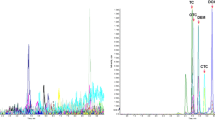Abstract
A simple, rapid, and specific ion-pair liquid chromatographic method for routine determination of the marker residue of oxytetracycline (OTC), namely OTC and 4-epi-oxytetracycline (4-epiOTC), in edible animal tissues (muscle, liver, kidney, and fat) has been developed. Minced tissue samples were acidified at pH 2.7 with 2 mol L−1 sulfuric acid and extracted with acetonitrile. The extracts were purified by treatment with ammonium sulfate solution and concentrated into 0.1 mol L−1 phosphoric acid. Baseline separation was carried out isocratically on a Nucleosil 100-5 C18, 5-μm column using an acetonitrile–0.01 mol L−1 disodium hydrogen phosphate (20:80, v/v) mobile phase that contained both positively (tetrabutylammonium) and negatively (octanesulfonate) charged pairing ions and EDTA, and was adjusted to pH 3.8. Detection was by UV at 370 nm. The method was fully validated according to Commission Decision 2002/657/EC. Overall recoveries were better than 82.6% and overall relative standard deviation was better than 6% for all the tissues examined. The good analytical characteristics of the method allowed limits of quantification as low as 30 ng g−1 for muscle and fat and 50 ng g−1 for liver and kidney, for both OTC and 4-epiOTC, to be realized. The method was successfully used to determine the OTC marker residue in tissues of two sheep intramuscularly administered a commercial OTC formulation.



Similar content being viewed by others
References
Kapusnik-Uner JE, Sande MA, Chambers HF (1996) Tetracyclines, chloramphenicol, erythromycin and miscellaneous antibacterial agents. In: Hardman JG, Limbird LE, Molinoff PB, Ruddon RW, Gilman AG (eds) Goodman and Gilman’s the pharmacological basis of therapeutics, 9th edn. McGraw–Hill, New York, 1123–1153
Debuf Y (1988) The veterinary formulary. Pharmaceutical Press, London, p 97
Commission Regulation 2377/90/EC (1990), as amended by Commission Regulation 508/99/EC. Off J Eur Commun L60:16–52
United States Code of Federal Regulations (1997). Title 21, par. 556.500
Codex Alimentarius Commission of the FAO/WHO (2006) Maximum residue limits for veterinary drugs in foods. CAC/MRL, pp 1–31
Commission Decision 2002/657/EC (2002) Off J Eur Commun L221:8–36
Kurittu J, Lonnberg S, Virta M, Karp M (2000) J Food Prot 63:953–957
De Wasch K, Okerman L, Croubels S, De Brabander H, Van Hoof J, De Backer P (1998) Analyst 123:2737–2741
Anderson CR, Rupp HS, Wu W-H (2005) J Chromatogr A 1075:23–32
Oka H, Ito Y, Ikai Y, Kagami T, Harada K-I (1998) J Chromatogr A 812:309–319
Oka H, Ito Y, Matsumoto H (2000) J Chromatogr A 882:109–133
Botsoglou NA, Fletouris DJ (2004) Residual antibacterials in food. In: Nollet LML (ed) Handbook of food analysis, Vol. 2, Residues and other food component analysis, 2nd edn, revised and expanded. Marcel Dekker, New York, pp 931–1035
Blanchflower WJ, McCracken RJ, Haggan AS, Kennedy DG (1997) J Chromatogr B 692:351–360
Zurhelle G, Muller-Seitz E, Petz M (2000) J Chromatogr B 739:191–203
Sczesny S, Nau H, Hamscher G (2003) J Agric Food Chem 51:697–703
Khong SP, Hammel Y-A, Guy PA (2005) Rapid Commun Mass Spectrom 19:493–502
Bogialli S, Curini R, Di Corcia A, Lagana A, Rizzuti G (2006) J Agric Food Chem 54:1564–1570
Fritz JW, Zuo Y (2007) Food Chem 105:1297–1301
Cherlet M, Schelkens M, Croubels S, De Backer P (2003) Anal Chim Acta 492:199–213
Cherlet M, De Baere S, De Backer P (2003) Analyst 128:871–878
Capolongo F, Santi A, Tomasi L, Anfossi P, Missagia M, Montesissa C (2002) JAOAC Int 85:8–14
Botsoglou NA, Fletouris DJ (2001) Drug residues in foods: pharmacology, food safety, and analysis. Marcel Dekker, New York, pp 985–1002
Oka H, Patterson J (1995) Chemical analysis of tetracycline antibiotics. In: Oka H, Nakazawa H, Harada K-I, Macneil JD (eds) Chemical analysis of antibiotics used in agriculture. AOAC International, Arlington, VA, pp 333–406
Cinquina AL, Longo F, Anastasi G, Giannetti L, Cozzani R (2003) J Chromatogr A 987:227–233
Brandstetetova EE, Kubalec P, Bovanova L, Simko P, Bednarikova A, Machackova L (1997) Z Lebensm-Unters Forsch A 205:311–315
Pena A, Lino CM, Alonso R, Barcelo D (2007) J Agric Food Chem 55:4973–4979
Nakazawa H, Ino S, Kato K, Watanabe T, Ito Y, Oka H (1999) J Chromatogr B 732:55–64
Zhao F, Zhang X, Gan Y (2004) J Chromatogr A 1055:109–114
Croubels S, Baert K, De Busser J, De Backer P (1998) Analyst 123:2733–2736
Croubels S, Vermeersch H, De Backer P, Santos MDF, Remon JP, Van Peteghem C (1998) J Chromatogr B 708:145–152
Acknowledgements
The donation of standard oxytetracycline and 4-epi-oxytetracycline by Pfizer Hellas (Athens, Greece) is acknowledged gratefully.
Author information
Authors and Affiliations
Corresponding author
Rights and permissions
About this article
Cite this article
Fletouris, D.J., Papapanagiotou, E.P. A new liquid chromatographic method for routine determination of oxytetracycline marker residue in the edible tissues of farm animals. Anal Bioanal Chem 391, 1189–1198 (2008). https://doi.org/10.1007/s00216-007-1823-9
Received:
Revised:
Accepted:
Published:
Issue Date:
DOI: https://doi.org/10.1007/s00216-007-1823-9




